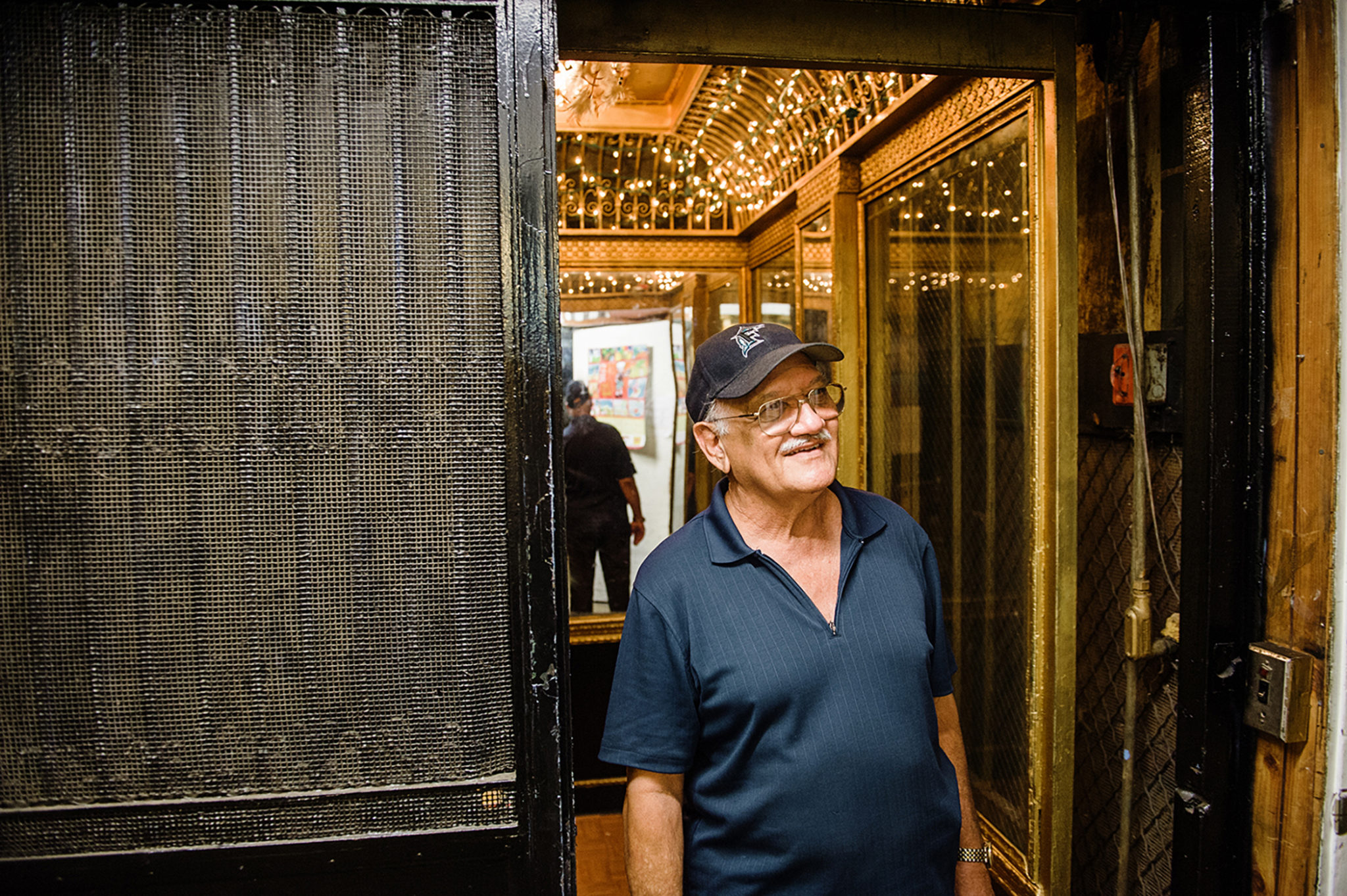Images by John Hook
At the decommissioned Blaisdell Hotel, Javier “Javi” Fombellida mans the levers of the last public hand-operated elevator in the islands. Seen from the Fort Street promenade, posted on a stool in a bird-cage-style elevator with a book in his hand, Fombellida looks like a statue. In many ways, he recalls artist Jodi Endicott’s sculpture What’s Next, which rests a few blocks away near Bishop Street and King Street, depicting a seated man reading his newspaper, waiting for a bus that never seems to come. That sculpture was installed in 2000, the same year Fombellida became an elevator man.
“This job takes patience, a lot of patience,” Fombellida says, gesturing around the empty lobby of the building that is now home to a hodgepodge of businesses, including a law firm, music studios, and various annexes of Hawaii Pacific University. In the first half of 2015, he reports reading between 40 and 50 books. At the age of 77, he sports a gray pencil mustache and trademark flat cap, a look that places him somewhere between the present and 1912, the year the hotel was built. While some of us mourn Honolulu’s turbulent past and others plot its suspicious future, Cuban-born Fombellida is perfectly content to go up and down, sometimes hundreds of times in a single day. He left Cuba in 1967 because, well, “Castro,” as he succinctly puts it. “He wanna kill me, I wanna kill him,” he says. So he hopscotched from Cuba to Miami to Connecticut, where he worked as a machinist for almost two decades before taking his family on a permanent vacation to Hawai‘i. Then, 15 years ago, he applied for the elevator job after seeing a listing in the local paper.

Most of the time, he serves businessmen and HPU students, but, he says, “We have crazy people every day here. Crazy people, drunk people, schizophrenics. Before, we had a psychologist on the second floor, and people came for that. But sometimes the people are so dirty I say, ‘Take the stairs, man.’ I’m bold. That’s the way I am. That’s why I am so far away from Cuba.”
In Fombellida’s cage, he’s woven decorative lights into the ceiling bars. We step in and he puts some old jazz on his radio. “You’ve already gone back in time,” he says, then yanks on the levers, and we jerk up to the fourth floor. He pulls down on the levers, and we descend. Passing each mid-floor section in the elevator shaft exposes a different colorful mural, a blur of birds and tropical landscapes—Fombellida’s handiwork.
“One time the elevator died, well a couple times, between floors,” Fombellida recalls. “One day with a lady inside. I had to use the stool and push her out to the third floor right there.”
Suddenly, we are in a dim yellow wash of faded fluorescent lighting, the basement. There’s a rat trap set on the floor, and perched right outside the elevator door is Fombellida’s fake stuffed rat. We poke around the musty corridors. He points out an otherwise inconspicuous plumbing pipe running along the ceiling. “That’s where the old building manager hanged himself,” he mentions. Incidentally, it’s also where Fombellida rigged up a witch costume on a pulley system so that he could tow it into visitors’ faces on Halloween. But what might seem macabre to some is just mischief to pass the time for Fombellida. “Sometimes I see … things, but I don’t believe in ghosts,” he says. “I always say it’s a shadow, or the light, or somebody’s probably there. Sometimes I want to see something, to make me a believer, you know?”

Although he’s too cynical to be haunted by the supernatural, Fombellida respects the past enough to question a time in which people no longer talk to each other in elevators. “Everybody looks down,” he laments. And yet, Fombellida’s contemporary enough to own a smartphone. He uses it to stay connected with people he meets through his work. “They tell me, ‘I’m going to be married,’ ‘I have a baby,’ ‘I miss you, Javi.’ I love that.” He takes his phone out of its holster and holds it up, explaining that there are three generations represented here. “Three steps—the elevator, me, and this phone. I’m right in the middle.”
This story was featured in our Charm Issue.

